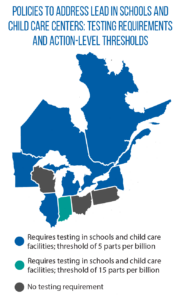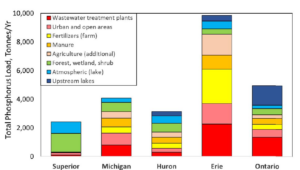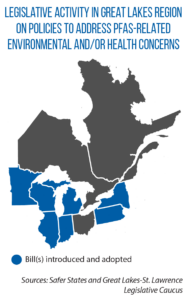Lead, Nutrients, and PFAS: 2023 Great Lakes Legislation
![]() The GLLC monitors state and provincial legislation in all 10 jurisdictions of the Great Lakes-St. Lawrence River basin, especially bills connected to the GLLC Policy Agenda.
The GLLC monitors state and provincial legislation in all 10 jurisdictions of the Great Lakes-St. Lawrence River basin, especially bills connected to the GLLC Policy Agenda.
So far in this biennium, the GLLC has identified and tracked more than 500 bills in the policy areas of water consumption, nutrient management, toxic substances, coastal resiliency, and aquatic invasive species. While the majority of these bills are still under consideration, more than 60 have been enacted. Several of these new laws address the goals and priorities laid out in the GLLC Policy Agenda.
Here is an overview of some of the recent legislative activity and progress.
Water Consumption
 In 2019, the GLLC Task Force on Lead approved this model policy, emphasizing reducing exposure to lead in drinking water in schools and child care facilities. The model policy calls for mandatory lead testing of all sources of drinking water in schools and child care centers. If lead is found to be in excess of 5 parts per billion, an alternate water source must be provided, and notification needs to be sent to parents and the coordinating state/provincial agency. The model policy further requires inventories of lead service lines, and for that information to be provided to affected residents.
In 2019, the GLLC Task Force on Lead approved this model policy, emphasizing reducing exposure to lead in drinking water in schools and child care facilities. The model policy calls for mandatory lead testing of all sources of drinking water in schools and child care centers. If lead is found to be in excess of 5 parts per billion, an alternate water source must be provided, and notification needs to be sent to parents and the coordinating state/provincial agency. The model policy further requires inventories of lead service lines, and for that information to be provided to affected residents.
Earlier this year, Michigan passed legislation to step up lead testing requirements. SB 31 requires the testing of minors, and under HB 4200, the results of those test must be included on the child’s immunization record. HB 4341, HB 4342 and SB 88 create the Clean Drinking Water Act, outlining funding and requirements to prevent exposure to lead in drinking water. The act calls for annual testing, as well as water filters, in all schools and child care centers. This legislation matches the shut-off threshold in school and child care centers agreed upon by legislators who helped develop the GLLC Model Policy: 5 parts per billion.
Michigan joins Illinois, Minnesota, New York, Ontario, and Québec in adopting this standard. Most of these jurisdictions adopted this requirement in the past five years. Indiana requires testing in schools with a 15 parts per billion threshold. Wisconsin, Ohio, and Pennsylvania encourage, but do not require, testing for lead in school and child care facilities.
Also related to water consumption, Québec approved a new water pricing policy with higher rates for commercial users and water bottlers. Additionally, Bill 20 creates a “Blue Fund” to collect these increased fees. This fund will then be used to finance projects for “…the protection, restoration, development, and management of water.” Set to go into effect in January 2024, the rates threshold will be lowered to 50,000 liters (roughly 13,000 gallons), increase by 3 percent annually, and include a surcharge for water withdrawn and placed in bottles or other containers.
Nutrient Management

International Joint Commission, 2021.
This year, the GLLC finalized policy recommendations on nutrient management with the final convening of its Task Force on Nutrient Management. One of the model policies highlighted in the recommendations is Wisconsin’s Producer-Led Watershed Grant Program. Wisconsin’s program allows agriculture producers within the same watershed to submit collaborative applications for projects to improve soil and water quality through voluntary nonpoint source pollution abatement.
Legislators expanded this program with this year’s passage of AB 65. This bill expands eligibility for the watershed grants, allows agricultural producers from adjacent watersheds to send in an application, and lists the producer-led group itself as an eligible recipient of funds, rather than a single member of the group.
Toxic Substances
 Earlier this year, Minnesota passed sweeping PFAS regulatory reform as part of the Legislature’s omnibus environmental policy bill, HF 2310. The bill includes a ban on class B firefighting foam containing PFAS, requires the Pollution Control Agency to establish drinking water quality standards for six classes of PFAS, forms a work group to recommend manufacturer fees, requires manufacturers of products with intentionally added PFAS to send detailed product information to the Pollution Control Agency, and moves towards the prohibition of products containing intentionally added PFAS in 2032.
Earlier this year, Minnesota passed sweeping PFAS regulatory reform as part of the Legislature’s omnibus environmental policy bill, HF 2310. The bill includes a ban on class B firefighting foam containing PFAS, requires the Pollution Control Agency to establish drinking water quality standards for six classes of PFAS, forms a work group to recommend manufacturer fees, requires manufacturers of products with intentionally added PFAS to send detailed product information to the Pollution Control Agency, and moves towards the prohibition of products containing intentionally added PFAS in 2032.
Minnesota’s action on PFAS could have national impact. Minnesota is the second U.S. state, after Maine, to establish mandatory reporting and a prohibition timeline for products with intentionally added PFAS. This legislative trend could increase the transparency and awareness of PFAS in common products and shift manufacturer behavior away from the use of these compounds altogether.
Keep up to date on Great Lakes legislation through the GLLC State and Provincial Legislative Tracker.

